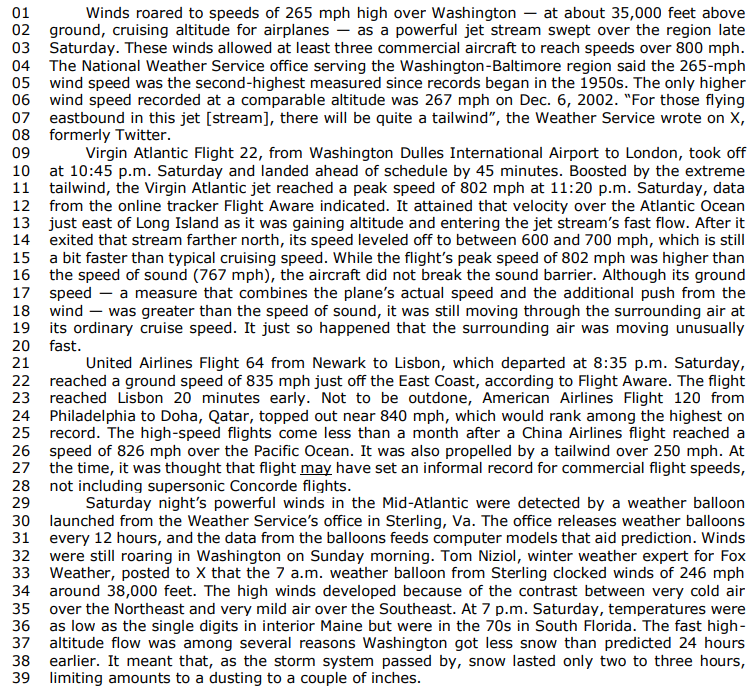Questões de Concurso
Foram encontradas 1.574 questões
Resolva questões gratuitamente!
Junte-se a mais de 4 milhões de concurseiros!
Planes top 800 mph as near-record winds sweep high over Mid-Atlantic

(Available at: www.washingtonpost.com/weather/2024/02/18/record-jet-stream-winds-dc-flights/ – text
specially adapted for this test)

Leia o trecho a seguir:
The Hardworking Family
John is a hardworking man. He always gets up early to work and to do all the things he has to do. Mary, John's wife, helps him and she usually spends a lot of time at work with John. John works all the time.
John and Mary have three children who often complain that their parents work too much and seldom enjoy life. They say, "Dad, you and Mom should take a break from work and try to have some fun. You never relax."
John's answer is: "Sometimes I think of taking a vacation, but who will pay our bills?". Mary agrees with John and says that someday their children will understand the situation.
(Adaptado de: <https://www.englishexperts.com.br>. Acesso em: 9 jun. 2023.)
Assinale a alternativa que apresenta a classe gramatical das palavras em destaque no texto:
“Os conectivos (connectives, ou linking words), também conhecidos como palavras de transição (conjuctive adverbs / transitional adverbs), servem para estabelecer uma ligação entre conceitos, ideias ou palavras em uma mesma frase ou entre frases distintas. Estes termos são importantes para manter o que chamamos de coesão de um texto, isto é, quando as ideias transmitidas em frases e parágrafos estão interligadas e seguem uma lógica. É justamente por existir coesão em um texto que podemos dizer que ele ficou claro ou fácil de compreender.”
(Adaptado de: <https://www.infoescola.com/ingles/conectivos-connectives/>. Acesso em: 7 jun. 2023.)
Com base nas informações do texto, analise o diálogo a seguir:
Lisa: Why did you go to the store?
John: I went to the store so that could buy some beer.
Em relação ao conectivo “so that”, é CORRETO afirmar que:
Plurilingualism and translanguaging: commonalities and divergences
Both plurilingual and translanguaging pedagogical practices in the education of language minoritized students remain controversial, for schools have a monolingual and monoglossic tradition that is hard to disrupt, even when the disrupting stance brings success to learners. At issue is the national identity that schools are supposed to develop in their students, and the Eurocentric system of knowledge, circulated through standardized named languages, that continues to impose what Quijano (2000) has called a coloniality of power.
All theories emerge from a place, an experience, a time, and a position, and in this case, plurilingualism and translanguaging have developed, as we have seen, from different loci of enunciation. But concepts do not remain static in a time and place, as educators and researchers take them up, as they travel, and as educators develop alternative practices. Thus, plurilingual and translanguaging pedagogical practices sometimes look the same, and sometimes they even have the same practical goals. For example, educators who say they use plurilingual pedagogical practices might insist on developing bilingual identities, and not solely use plurilingualism as a scaffold. And educators who claim to use translanguaging pedagogical practices sometimes use them only as a scaffold to the dominant language, not grasping its potential. In the United States, translanguaging pedagogies are often used in English-as-a-Second Language programs only as a scaffold. And although the potential for translanguaging is more likely to be found in bilingual education programs, this is also at times elusive. The potential is curtailed, for example, by the strict language allocation policies that have accompanied the growth of dual language education programs in the last decade in the USA, which come close to the neoliberal understanding of multilingualism espoused in the European Union.
It is important to keep the conceptual distinctions between plurilingualism and translanguaging at the forefront as we develop ways of enacting them in practice, even when pedagogies may turn out to look the same. Because the theoretical stance of translanguaging brings forth and affirms dynamic multilingual realities, it offers the potential to transform minoritized communities sense of self that the concept of plurilingualism may not always do. The purpose of translanguaging could be transformative of socio-political and socio-educational structures that legitimize the language hierarchies that exclude minoritized bilingual students and the epistemological understandings that render them invisible. In its theoretical formulation, translanguaging disrupts the concept of named languages and the power hierarchies in which languages are positioned. But the issue for the future is whether school authorities will allow translanguaging to achieve its potential, or whether it will silence it as simply another kind of scaffold. To the degree that educators act on translanguaging with political intent, it will continue to crack some openings and to open opportunities for bilingual students. Otherwise, the present conceptual differences between plurilingualism and translanguaging will be erased.
Source: GARCÍA, Ofelia; OTHEGUY, Ricardo. Plurilingualism and translanguaging: Commonalities and divergences. International Journal of Bilingual Education and Bilingualism, v. 23, n. 1, p. 17-35, 2020.
Garcia e Otheguy (2020)
Observe the following comic strip and select the correct alternative: